Text
Copenhagen: Wide Open Spaces
One cannot leave Copenhagen without the feeling that it is a vibrant, cosmopolitan capital city. Copenhagen’s reputation as one of the world’s great food cities is well earned, with options ranging from dozen-course, Michelin-star caliber dining to one of the most remarkable street food markets in Europe. A commitment to the arts, expressed through the Royal Danish Opera House, Royal Danish Playhouse, and an impressive collection of state and privately run museums help cement Copenhagen’s place as a significant cultural center. However, when I step back and think about the Western capitals (or even major cities generally), one comes to expect things like the arts, well curated museums, and interesting dining. The execution of course varies by culture, but in an era when cultures diffuse more rapidly than ever, I am drawn to what makes a city unique in a way that cannot easily be readily transferred even to culturally similar neighboring countries. Copenhagen’s uniqueness comes from a combination of open spaces and its inhabitants’ love of those spaces.
Several factors contribute to that open feeling. The first is that Copenhagen has very few tall buildings. A view from the top of one of the tallest buildings in the city, Vor Frelsers Kirke, shows rooftops of a suspiciously similar height.

This uniformity reminds me of Washington, D.C., and it turns out these cities have something in common - laws restricting maximum building height. The only exceptions in most of Copenhagen are church towers and the Ørestad district, which is all new development. Based on Ørestad’s failure to attract residents in spite of its proximity to the city center, one can infer a Danish preference for low-rise living.
The next factor contributing to the feeling of spaciousness is the especially wide streets. The main thoroughfares tend to consist of a four-lane road, dedicated bike lanes fully partitioned from the road, each wide enough to fit several riders abreast, and finally an unusually broad sidewalk, at least by American standards. Furthermore, walkways are largely unencumbered by street lamps and stoplights. Copenhagen has a remarkable system of lights suspended from high tension wires running from building to building. The city installed this system in the 1970s and are keeping it up to date - many of the lights I saw used LEDs.

Copenhagen seems to be brimming with parks and public spaces. There are quite a few private parks, something I found out staying in an apartment off Nansensgade. In what looks like a brilliant piece of city planning, many apartment buildings share huge interior courtyards. A satellite view of the neighborhood shows this clearly. Our building’s courtyard had picnic tables and Adirondack chairs, a trampoline, and enough room for kids to play soccer without breaking a window. Even without one of these courtyards, public spaces abound.
What matters even more than the presence of parks and public spaces are the way the people relate to them. I saw people spending considerable time in public all over the city, including in some completely unexpected settings. Drunning Louises Bro, a bridge over one of the manmade lakes (”The Lakes”, themselves a wonderful space), is ringed by people enjoying the sun and the water from afternoon through evening every day of the week. The bridge often had DJs playing on cargo bikes converted to mobile sound systems with the occasional full band thrown in for good measure. We saw people from every walk of life gathering on the bridge, usually enjoying each other’s company over a beer—usually Tuborg—as open containers are welcome in Denmark.
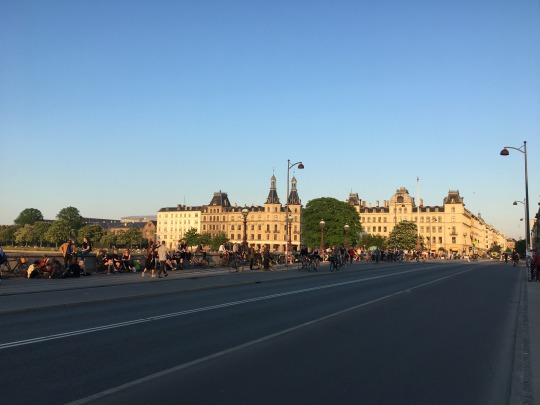
Near the end of our time in Copenhagen, we took a walk through Assistens Cemetery. a burial place of many of the city’s historical figures. There we witnessed something I am certain we have never seen before - people picnicking, sunbathing, and reading amongst the graves. Assistens Cemetery is still in active use, with burials weekly, yet it was clear the city put in effort to make it a cemetery for the living; well maintained pathways and plenty of benches presented peaceful nooks for solitary reverie or quiet companionship in small groups. The thoughtful consideration given to meeting the needs of the dead and the living made this particular “park” exceptionally unique and compelling.
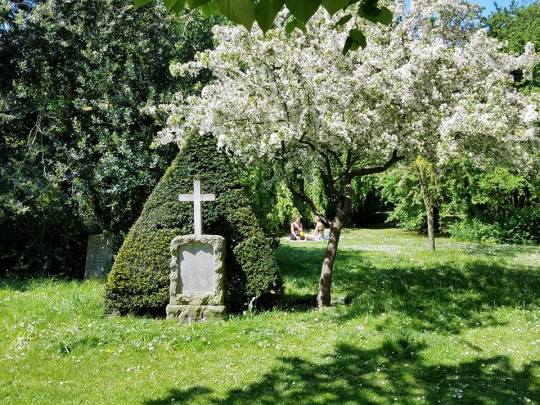
While public spaces in Copenhagen are incredibly diverse, they have something important in common - they feel inviting. I suspect that limited automobile traffic plays a part here - it keeps the air quality up and you aren’t fighting to hear conversations over traffic noise. Most of the spaces have copious seating in some form, be it steps, benches, or hillsides. Finally, and perhaps most critically, the spaces are small enough to fill up. A small, relatively full venue feels so much more lively than a giant, mostly empty one.
Copenhagen’s excellent public spaces were a revelation; partaking in them with the locals was the most unique, enjoyable part of a great city.
0 notes
Text
Helsingør and Helsingborg, Fortifications and Ferries
After a week in Copenhagen, it felt like we had seen much of the city and our last day in Denmark might be better spent exploring the surrounding area. The most visited museum in Denmark, the Louisiana Museum of Modern Art, lies just 35km north of Copenhagen and is easily reached by train. This museum is an attraction, known for its architecture and use of the landscape. Visiting it on our last day in Denmark felt like a no-brainer.
We started our day early and reached the train stop for the Lousiana well before it opened, so we continued the train ride to the nearby city of Helsingør. Helsingør is known for two things: Its Kronborg castle is the setting for Hamlet and it is the narrowest point of the Øresund, the body of water separating Denmark from Sweden. The castle was built there precisely because the strait is so narrow (4 km) - as the only passage to the Baltic Sea, this waterway was of tremendous strategic importance. Denmark relied on tolls paid by ships passing through the sound for much of the state’s income.
It was still too early in the day to visit the castle so we headed to the ferry terminal, which connects directly to the train station. The ferries run to Helsingborg, Sweden, about 4km away directly across the strait (The “HH” route) . This is the busiest car ferry line in the world, with over 70 departures in each direction daily, one every 15 to 20 minutes.
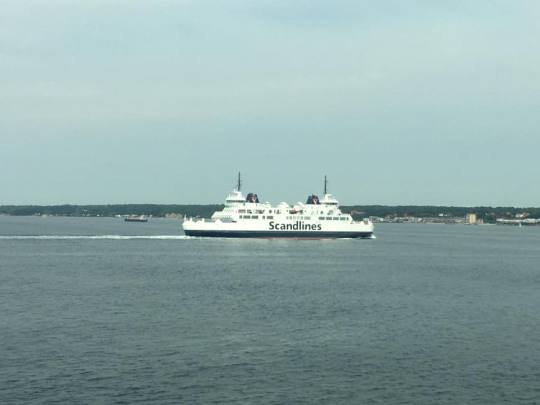
We quickly found out these are large boats. The lower decks are packed with so many 18-wheelers that truckers have their own lounge. The Scandlines boat we took, the Aurora, runs entirely on battery power! In addition to the environmental benefits, it proved remarkably quiet. We weren’t sure what we might do on the Swedish side, but met a young Dane onboard who recommended we head straight to Kärnan once we reached the dock. Like every recommendation we have received from a local so far, this one turned out very well.
The Kärnan (literally “the core”) is the keep of the long-since destroyed Helsingborg castle. From a distance, the age is impossible to guess - the brickwork looks nearly flawless. Given its location in the middle of a beautiful park, it looks like it could be a folly like the Broadway Tower in England. I was gobsmacked to find out this it built in the 1310s. Centuries of soot blacken original oak beams in the kitchen. While it is not a huge building, we spent a good bit of time here. The audio tour is very well done, detailing the goings-on in every room from lower storage to the rooftop.
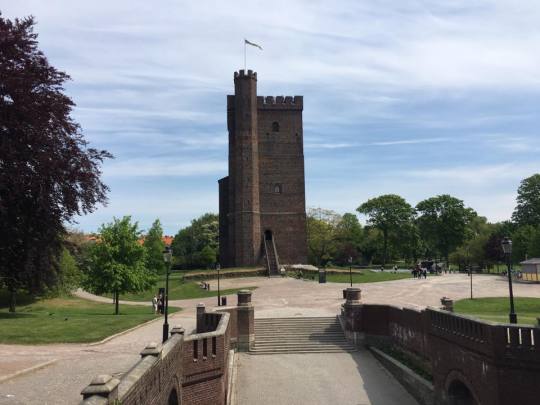
After visiting the Kärnan, we pulled an audible. The Kronborg practically beckoned to us from across the straight (it is easily seen from the top of the Kärnan). Exploring one of the world’s best preserved renaissance castles seemed like a better call than heading to another museum, even a highly regarded one. We stopped for lunch on the Swedish side and hopped the ferry back.
The walk to the Kronborg from the ferry terminal is a pleasant one, offering great views of the castle and the waterfront. The fortifications impressed even before we reached the front gate. We later learned that the Swedes captured Kronborg in the 17th century, but the Danes learned their lesson, making it one of the best fortified castles in Europe. As part of an attacking force, your reward for somehow crossing a deep moat and scaling a 20 foot wall (while getting shelled) was facing yet another, deeper moat and a 40 foot bonus wall.

There are many entrances to explore once inside the castle. We started with the highlight of its art collection, a series of 16th century tapestries depicting the lives of Danish kings. Through their sheer scale and ornate detail, the tapestries also powerfully display the wealth of the kingdom. The other highlight of this visit were the rooms and construction of the castle itself. Its ballroom was once the largest hall in northern Europe. It looks amazing and, at over 200 feet in length, feels gigantic.

We ended our time in the castle by visiting the chapel. When the royalty discontinued use of the castle, it became a military outpost. The military needed a place to work out so they removed all of the furniture from the chapel, converting it to a gymnasium. Fortunately they saved everything removed from the chapel in the conversion, allowing a later restoration using all of the original furniture and fixings.
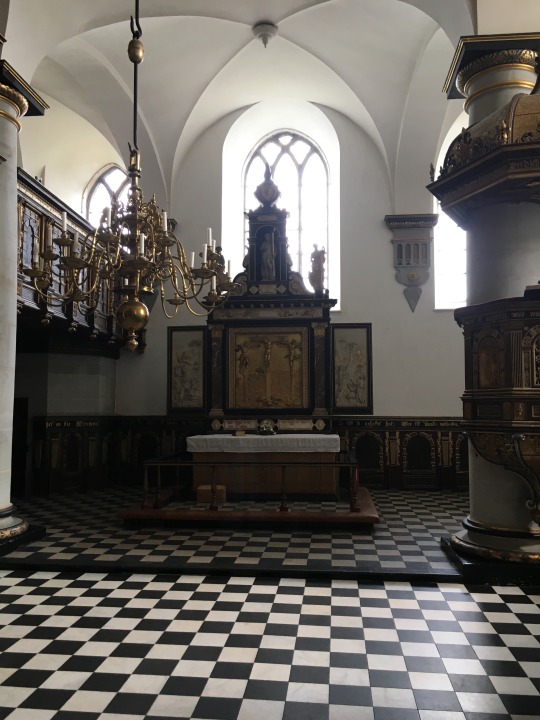
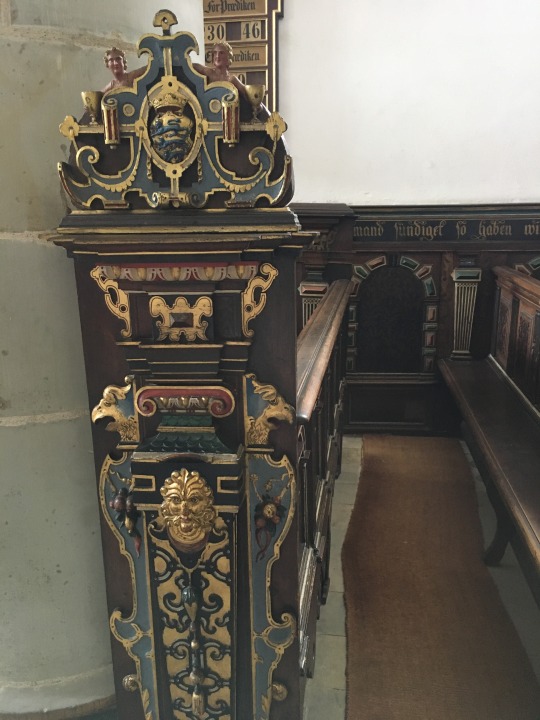
With our visit to the castle completed, it was time to bid Denmark farewell. The next leg of the Big Nordic Adventure will find us in sunny (hopefully!) Stockholm, Sweden.
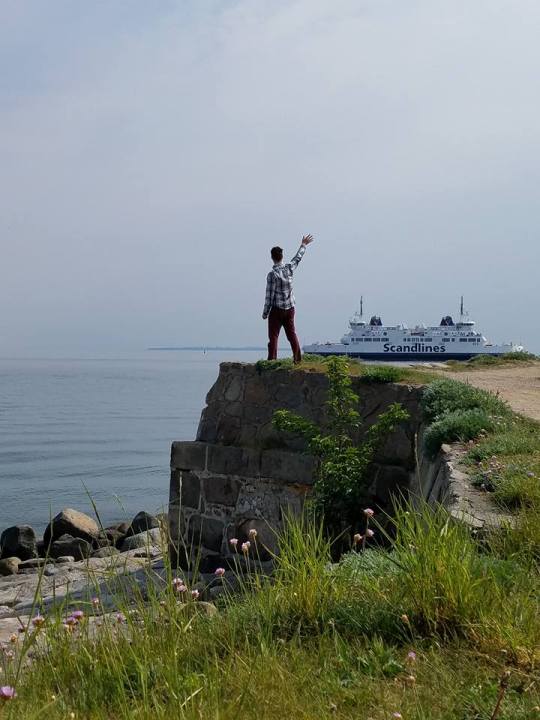
0 notes
Text
Adventures in the Arctic, Part 2: The city of Tromsø
Following our time on the Kaldenfjord, we returned to Tromsø city proper, where we flew in before heading out to the countryside. Tromsø is the northernmost city in the world (as defined by a population of 50,000), hence it is heavily represented in Wikipedia’s list of northernmost items. Some of these northernmost attractions made for some interesting sightseeing.
Tromsø claims the world’s northernmost botanical garden, which of course sits on the southwestern corner of world’s most northern university (University of Tromsø). From the city center, one can get here via Tromsø’s excellent bus service. We ended up walking there to see the more industrialized side of town. There appear to be some very serious fishing vessels based out of Tromsø. They also have a fire station that, with 21 bays, was so large I had to wonder if large quantities of halibut sometimes spontaneously combust.
The botanical garden’s collection sensibly works with the latitude, with plants from cold weather climes all over the world. We were pushing the season pretty hard coming here in mid-May; the season was just starting to turn and snow still covered the pathways through the grounds, though the plants themselves were largely dug out. A handful of unusual (and almost universally tiny) flowers were already in bloom.
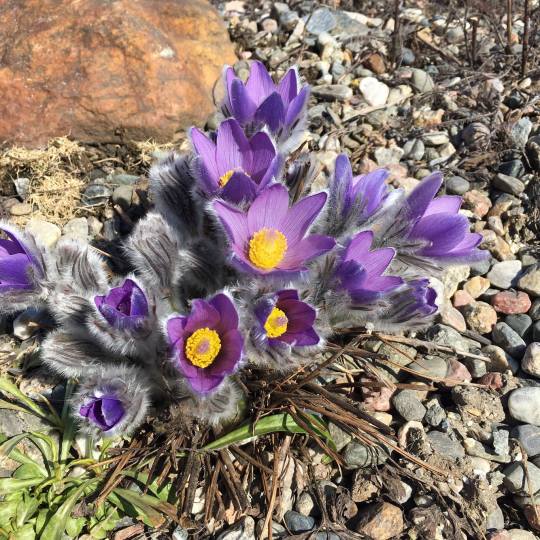
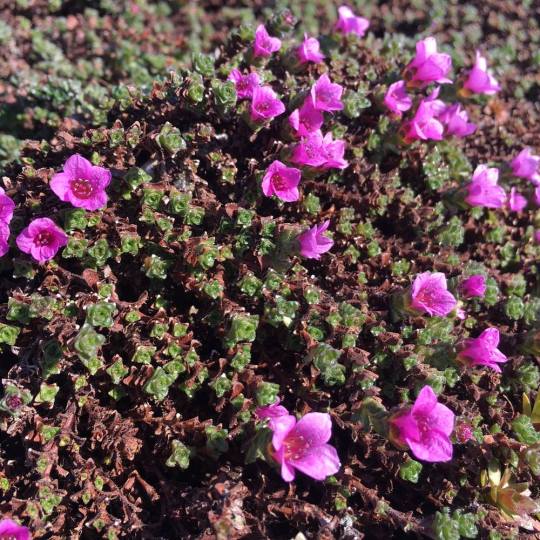
We love learning about local culture and history, so we also made a point of visiting the Tromsø University Museum primarily to see its exhibits on the history of the Sami people in Norway. The Sami have had a rough go of it, to put it mildly. A view of their historical range at the very start of the exhibit (similar view shown below) displayed a problem that would challenge any group of people. Their domain is split over four countries!
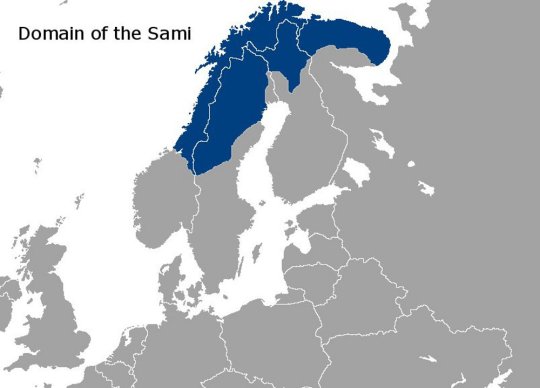
Norway began a policy in 1860 to Norwegianize the Sami people, starting with eliminating the use of their language (thought of at the time as “inferior” and “an impediment to progress”). This poster shown in the exhibit pretty well sums it up, using a caricature of a Sami child to invite tourism to Norway even as they were trying to stamp out their culture.
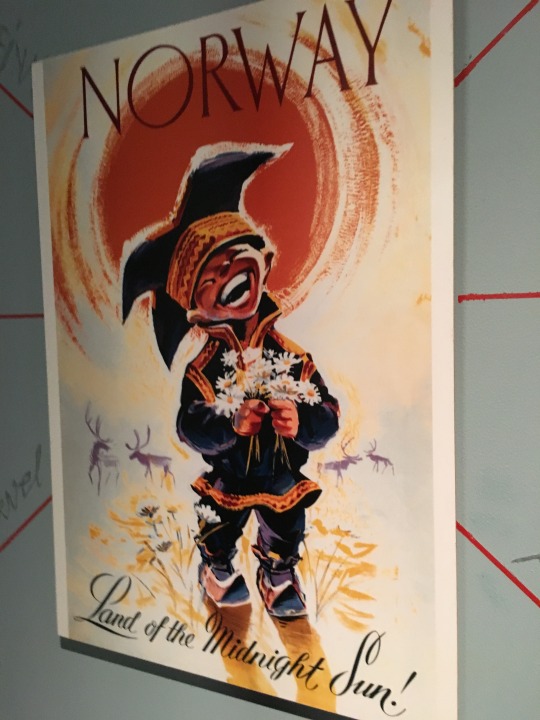
Despite pressure to assimilate, Sami culture held on through World War II, when scorched earth warfare annihilated their lands. This compelled the Sami to adopt more modern ways of living. One might reasonably think this would have been the end of the Sami as a distinct group of people, but then a sort of miracle occurred in the form of a Sami cultural revival. They fought to bring back their language and traditions and ultimately won. The Norwegian constitution was amended in 1988 to recognize the Sami as indigenous people with a right to preserve their way of life.
Coming from the United States, the language in the museum discussing Norway’s treatment of the Sami seemed remarkably political. I saw quite a few parallels with the mistreatment of our own indigenous peoples. The closest analogue I can think of are the Hawaiian people, who also brought their language and culture back from the brink.
The museum also has some remarkable artifacts from this region, which has been populated for over 10,000 years. Lots of interesting things made from bone and antler, like this 9000 year old reindeer-horn fishing hook.
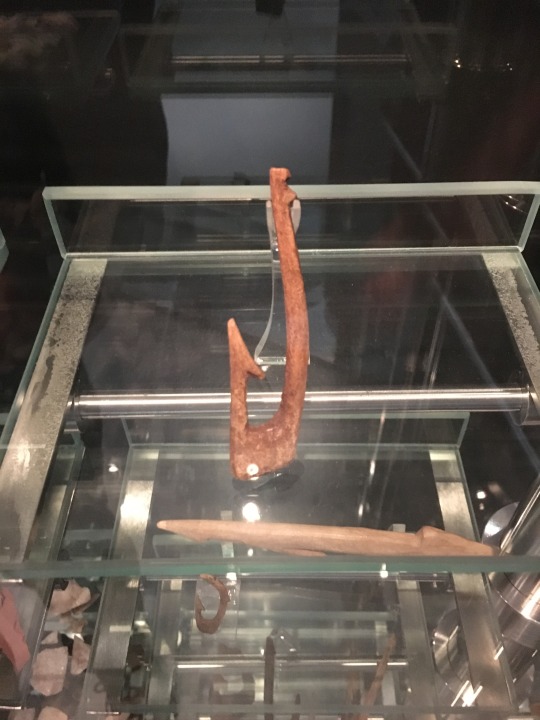
We spent the remainder of our time exploring the town. There is some wonderful architecture here. The geometric cornucopia in the first photo is the famous Arctic Cathedral (actually a parish church), made from aluminum and concrete. The second photo shows Tromsø’s beautiful public library.
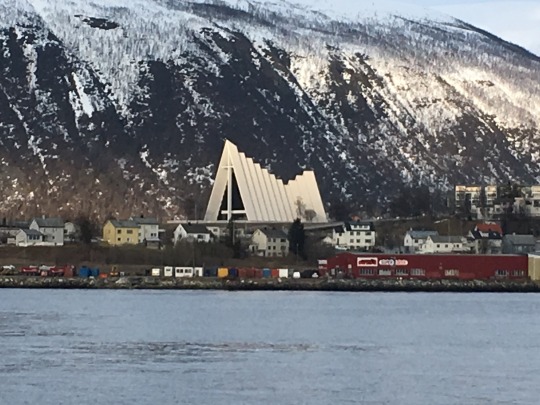

We learned something else about Tromsø without leaving our apartment - they run and incredibly impressive recycling program up here, the most sophisticated in the country. The municipality provides five different colors of waste bags to residents:
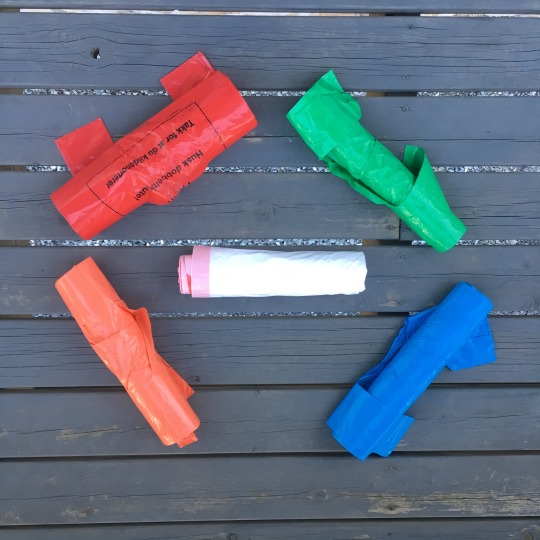
* Green for food waste, which is turned into biogas and fertilizer
* Blue for plastic, recycled
* Orange for beverage cartons
* Red for paper
* White for remaining waste
Waste not recycled is incinerated to generate power. Electronics are brought to stores that sell electronics or recycling centers.
We hoped to ascend Tromsø’s well known aerial tramway, the Fjellheisen, but were foiled when they declared a four day, unscheduled maintenance period the morning of our last day in town. We later learned unplanned outages on the Fjellheisen are common, though the usual culprit is high winds. We made a mistake by not jumping on this at the earliest opportunity.
This concluded our time in Norway. We didn’t know what to expect going north of the Arctic circle and found beautiful scenery, friendly people, a very nice city, and interesting culture. The next leg of the Nordic adventure will take us to Cophenhagen, where we will trade in our parkas for bicycles.
0 notes
Text
Dining disappointment in Denmark: Relaæ, reviewed
Rating: 0 Stars / Fair (borrowing the scale used by the NYT)
Price: DK475 ($71.30USD) for the four-course Relaæ Menu
Relaaæ has been around long enough (7 years) that it might be fairly called a Copenhagen staple. Some even credit it for gentrifying one of the most dangerous blocks in Nørrebro. Relaæ earned both a Michelin Star and a place on the World’s 50 Best Restaurants list for its innovative flavors and unpretentious approach to fine dining. They offer a four course “Relaæ Menu” and a seven course “Relaaæ experience”. We opted for the former.
I found the green asparagus and elderflower tart hors d'oeuvre very light and fresh, though I could not detect any elderflower. The oyster and cucumber dish was a really unique and delicious take on oyster - effectively a salad, with a creamy oyster emulsion as the dressing. The dehydrated potatoes, “rehydrated” with butter and topped with a parmesan sauce, were absolutely stunning. I cannot imagine how they prepared the greens in the main course, pork and spring greens - they were the most flavorful greens I have ever tasted. The desert, a buttermilk sorbet layered over smooth caramel with a nitrogen-frozen-then-powdered chervil topping, was as refreshing as it was innovative.
The only item lacking in execution was the sourdough bread. The crust looked great, but the middle of the loaf was clearly underdone, returning to dough with a slight squeeze.
I have no complaints about the service, in fact, I thought the staff seemed quite enthusiastic and never skipped a beat. Given all I have said so far, how can I possibly justify rating Ralaæ so harshly? It all comes down to portions.
Relaæ served portions so small that by the end of the meal, I felt as though I had skipped dinner. The asparagus tart consisted of a single bite. The oyster dish contained far less than the meat from a single chopped oyster. The rehydrated potatoes were rich, but could have fit onto a single fork. The main course included two thin slivers of pork, neither of which could have weighed more than an ounce.
I expect almost any fine dining experience to consist of fairly small portions, especially when the flavors are rich. I think it normal for a fine dining establishment to leave its patrons wanting a bit more, but at some point, portions go from being small to stingy, and I thought Relaæ was well on the wrong side of this line. The ingredients on the menu were things i think of as being reasonably priced (if not cheap), even when one goes for organic vegetables and humanely raised meat, so the diminutive portions seem especially hard to justify.
The flavors were great, but this place is still a terrible value. Avoid or risk finding yourself cooking soft-boiled eggs at 11PM.
0 notes
Text
Adventures in the Arctic, Part 1: The Kaldenfjord
Our time north of the Arctic Circle started out on the Kaldenfjord, northwest of Tromsø. We drove until the road ended on the northern shore of the fjord without reaching our destination. I wondered if Google had simply not mapped out this part of the world yet; perhaps we needed to drive around the fjord in the opposite direction? A closer look at the map indicated there were no other options, so we started walking through the snow at the end of the road. After about 150m, we saw the residence (lower floor of the yellow house).
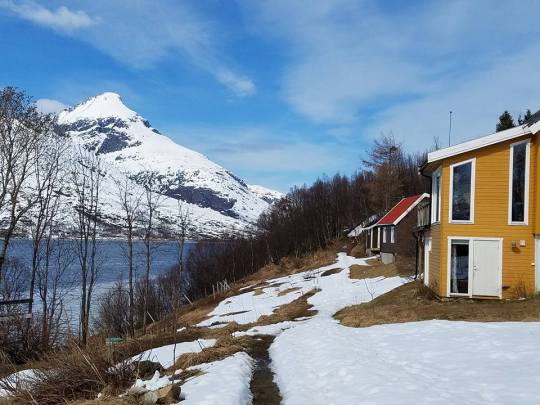
This turned out to be a killer Airbnb find. The flat itself was lovely - the host, a yoga instructor, made the paintings in the forthcoming images. The views speak for themselves.
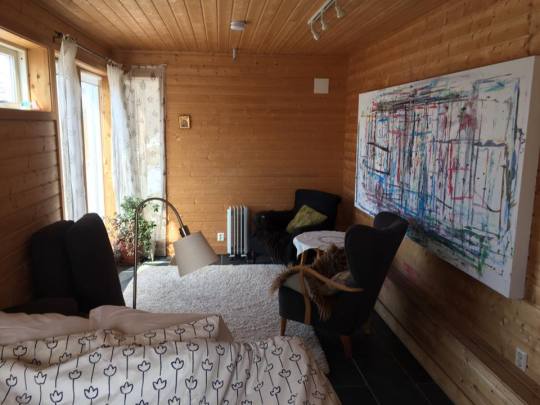

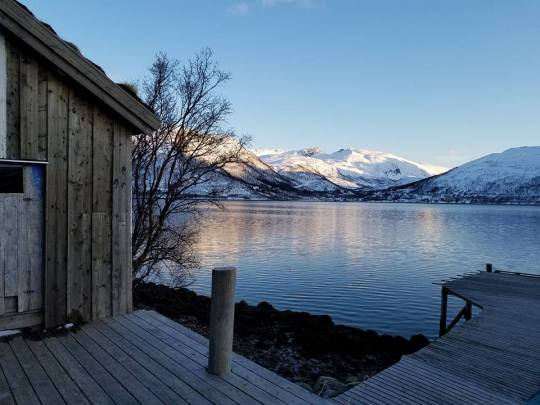
We soon found out that a Sami reindeer herder lived down the street. Scenes like the one below occurred regularly throughout the day.
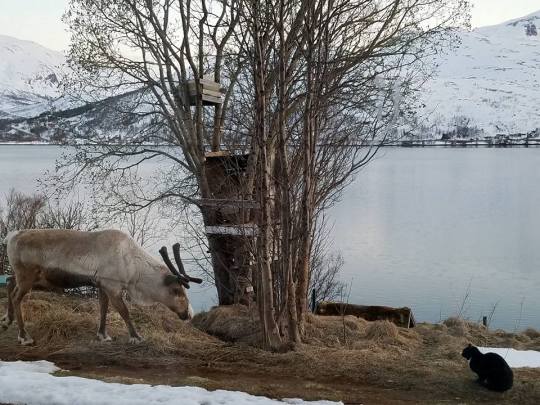
We saw paths in the woods beyond the next group of houses, with the only point of access lying on the opposite side of an adjacent property. I felt a bit reluctant to cross another property until I recalled that the freedom to roam is very well enshrined in Norway’s laws and culture, which effectively means private property cannot block access to nature. This includes all uncultivated land, regardless of ownership. We walked for a while and found houses a considerable distance from the end of the roads, leaving snowmobiles and ATVs as the only conceivable means of access.
The remoteness of our lodging meant doing a bit of cooking. If you like eating freshly caught sea creatures, you'll love northern Norway. The single grocery store in our neck of the woods, Eide Handel, had the best selection of fresh fish I have ever seen, including some pretty unusual things (by American standards), like Kvalbiff, literally "whale beef". Fruit and vegetables are a bit hard to come by up here - most bananas in Norway looked like they came here by way of rock tumblers. People here necessarily rely on cured, canned, and dry goods. I wanted to try the Coq au Vin in a can, but not at NOK 619 (roughly $70 USD)!

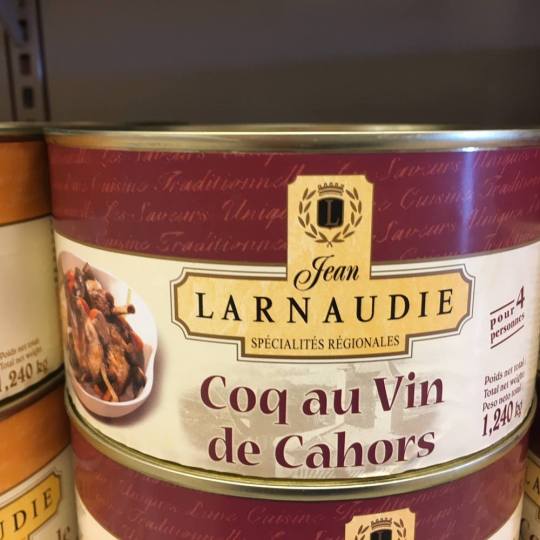
While our lodging felt pretty far afield, we wanted to go farther still. Our host suggested we visit Rekvik, a hamlet with just two permanent residents. Driving to Rekvik mandates a vehicle with four wheel drive and some ground clearance. Paved roads end in Tromvik, so one must cross the mountain on 6km of unimproved roads with deep ruts, steep gradients, and countless large, sharp rocks capable of puncturing a tire or piercing and oil pan. Emerging from the mountaintop and seeing the open ocean felt like reaching the end of the earth. The village itself appeared abandoned when we arrived, with all houses dark and no cars or boats present. We later found out many tourists get stuck here with broken down cars. I was thankful to make it out of there safely.

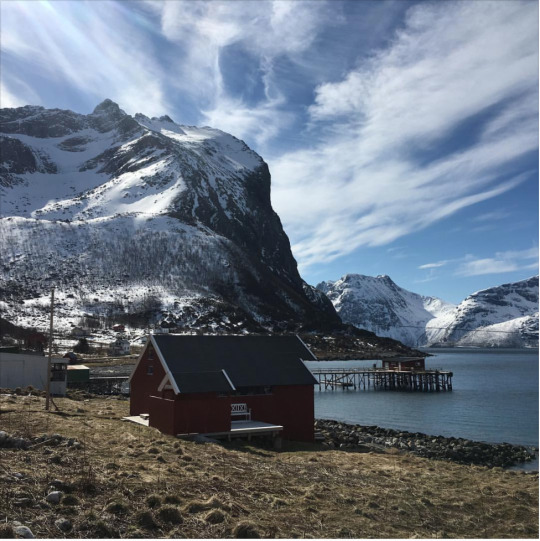
We took the rest of the day to relax after this experience, though it must be said that a day seems like a very loosely defined concept in the land of the midnight sun. I found it disorienting - I awoke every morning to blinding sunlight, thinking I badly overslept, only to find it was 4am. The sun shines with remarkable intensity in the clear, dry Norwegian air. The sun burned my eyes while I was wearing sunglasses. A knit cap with a visor (these exist!) pairs well with a very dark pair of shades.
We discovered still more wonders in our neighborhood on the fjord. At the Hanseatic Museum in Bergen, we learned how Norwegians prepared stockfish for trade in the days before refrigration, by drying whole fish in the open air. During the winter months, the dry, saline air alone is enough to dehydrate and preserve the fish. We discovered that this technique is still widely in practice on the Kaldenfjord. We saw many drying racks, though only a couple with fish still on them as in mid-May it was getting late in the season. I asked the people living next door about their fish drying operation. One of them exlaimed "Oh, you're interested in fish drying!" and promptly gave me a fish. It found it delicious, much better than jerky. I could see myself eating several of these fish a week were they available in the States.
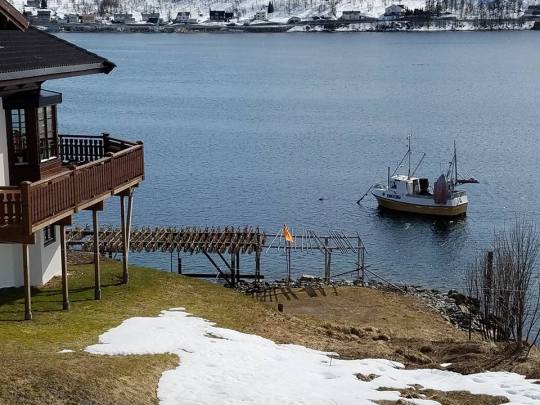
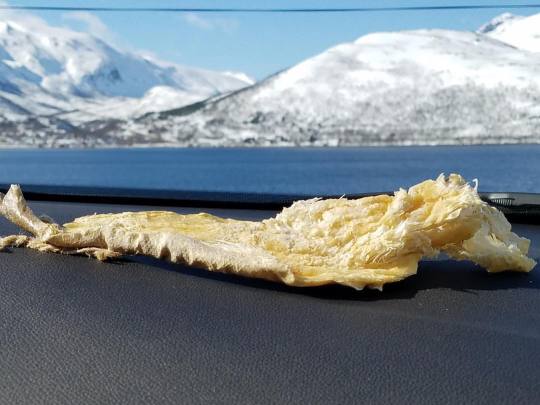
The aforementioned anecdote gives a good representation of the responses I received from people all over Norway, especially when taking an interest in their culture and customs. The locals were, to a person, incredibly friendly and informative. I can scarcely imagine feeling more welcomed as a foreigner.
Our last adventure in the countryside consisted of a lap around the southern end of Kvaløya ("whale island"), a large island on Norway's western shore. I thought I reached a saturation point for seeing natural wonders on the previous day, but if there is any lesson I can take away from touring Norway, it is this - at the very moment when you think that maybe you've finally seen it all, something else comes along to exceed your expectations.
The terrain changes quite a bit as one leaves the fjords and reaches the open ocean. White sand beaches lead out to clear, aqua-blue water, reminiscent of the Caribbean.
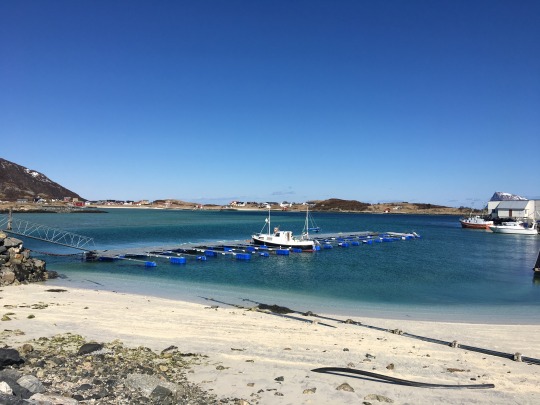

Thankfully the southern loop around Kvaløya proved less stressful than the road to Rekvik - all of the roads are paved. At the western tip of the island, we found the bridge to Sommarøy, a ~300 person fishing village on a much smaller island, Hillesøya. These people make their living fishing, and one gets the impression they do very well for themselves - think sizable houses with German cars in the driveway. Every fishing vessel and piece of related industrial equipment looked absolutely spotless and thoroughly modern.
We continued to the southern side of the island where we saw grazing lands with sheep and horse farms. Here we also encountered a moose, and by that I mean I am glad we did not collide with it. We thought it to be a cow based on the absence of antlers.

From here, we continued on to Tromsø proper, where we will pick up part two of our time in the Arctic in the next post.
0 notes
Text
Observations on Norwegian fitness culture
One of my great joys is weightlifting. I spend 8-10 hours a week in the gym and have done so for 18 years. I find the prospect of spending time away from the gym very upsetting, so one of the first things I do when traveling is determine when and where I am going to lift. After working out in three Norwegian cities, I can say with confidence that the fitness culture here feels very different than that of the United States.
Every Norwegian gym I saw had very solid olympic lifting and powerlifting equipment. In the United States, urban big box gyms never have this stuff - the only places where one finds bumper plates, deadlift platforms and the like are Crossfit boxes. Norwegian gyms also have regular weightlifting equipment that typical Crossfit boxes lack.
The way women in Norway approach fitness struck me as especially notable. In the US, most women at gyms partake in activities like aerobics and yoga. If they lift weights, they are usually light, and frequently in the context of machines instead of free weights. Women in Norway, on the other hand, are mostly iron throwing badasses. Heavy, high effort lifts using free weights appeared commonplace. I saw terms like “booty builder” in a few of the gyms. Muscular builds appear to be a point of pride for both genders.
Wearing the same pair of sneakers on a trip to the gym and then working out in them is commonplace in the United States, but Norwegians consider this a faux pas or outright impermissible. In fact, you often need to put covers over your street shoes (cleanroom style booties) just to make the trip from the entrance to the locker room. Quite a few people in Norway work out in socks! They definitely deadlift in socks :)
Fitness culture extends outside of gyms - almost everyone here seems to own a pair of skis. When we walked up Mount Fløyen in Bergen on a weeknight, there were many people of all ages walking briskly up the mountain instead of using the funicular. Obesity is exceedingly rare even in the two largest cities.
I loved the fitness scene here and look forward to comparing it to those in the other Nordic countries.
0 notes
Text
Bergen: A Whirlwind Tour

Our travels through the Norwegian countryside by train, bus, and ferry ultimately landed us in Bergen. We allotted ourselves just two days here in favor of more time in the Arctic. Framed by water and mountains, it reminded me a bit of Pittsburgh viewed from a distance.
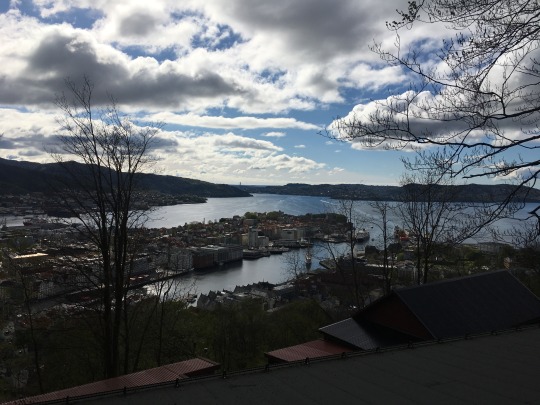
Learning about Bergen’s rich history very much added to my enjoyment of the visit. Bergen’s membership in the Hanseatic League shaped a significant part of its evolution and the Hanseatic Museum on the Bryggen compellingly recounts this story. The museum resides in the best preserved of the famous wooden houses from the early 18th century. Some of the rooms are arranged as they would have been when the house was in use and include detailed descriptions of the artifacts therein. The house itself is still unheated (and Bergen can be damn cold), enhancing an already powerful portrait of life when maritime trade dominated the economy.
While one might expect to find many old buildings in a city that functioned as a trading post for a thousand years, few structures date before 1702, the year a fire razed over 90% of Bergen. Many of the oldest houses are in Fjellet Nord, a neighborhood on a hill overlooking the Bryggen. I found it interesting that this area, like the rest of the city, was very much under construction. Quite a few old houses have what look like very modern additions - energy efficient windows, balconies made from modern materials, even a few garages. I found this especially refreshing coming from San Francisco, a city with far less history yet far more determination to resist change.
View of a typical street in Fjellet Nord:
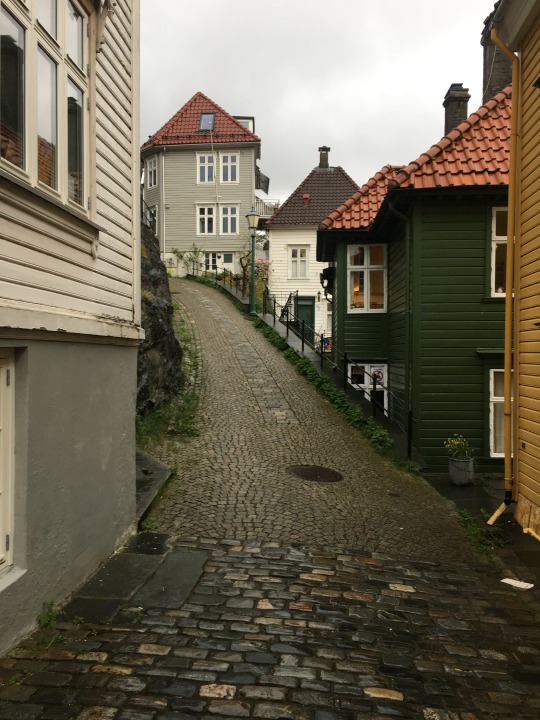
Bergen also has plenty of brand new construction. We made a trip across the city to see Treet (literally “the tree”), the tallest wooden structure in the world at 14 stories. It achieves this height through the use of modern engineered wood, hence the term “plyscraper”. Treet also shows beautiful architecture befitting such an engineering marvel. The best views are had from the left side of the Puddefjord Bridge crossing from the city center.

We would have preferred to spend more time outdoors exploring the city, but a combination rainstorm and cold snap moved in. Some amount of rain is nearly inevitable when visiting Bergen, where it rains 200 days a year and the least rainy month averages ~13 rainy days.
The rain gave us an opportunity to discover KODE 3, which gets everything right that the Munch museum in Oslo gets wrong. This museum does a wonderful job of showing the evolution of Norwegian art starting with I.C. Dahl’s landscape work. The Norwegians evolved to favor capturing people as they were instead of artificial poses. Much like the Vigeland installation in Oslo, many of these works are very engaging and human. I found “Sleeping Family” by Christian Krohg a remarkable example of naturalist art.
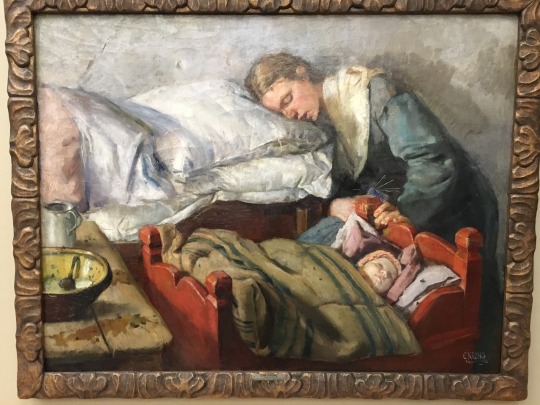
KODE 3′s Edvard Munch collection is second to none, far surpassing the Munch museum in Oslo. The works span every phase of his career and are arranged to show his evolution as both an artist and a human being. This museum also felt lightly trafficked compared to the Munch museum.
After visiting KODE 3, we thought it might be the last thing we would do in Bergen. We wanted to explore Mount Fløyen, but the weather was absolutely bone-chilling, so we gave up on this idea and returned to our flat to spend some time reading, relaxing, and thawing out. However, all was not lost. The weather can turn very quickly in Bergen, and around 6PM, the skies suddenly cleared, giving us nearly 4 hours(!) of sunlight to explore the mountain.
The most typical route up the mountain is the Fløibanen, a funicular that travels from the city center straight to the best viewpoint in the city. A funicular is rare in and of itself. This example features a curved track, making it especially unusual.
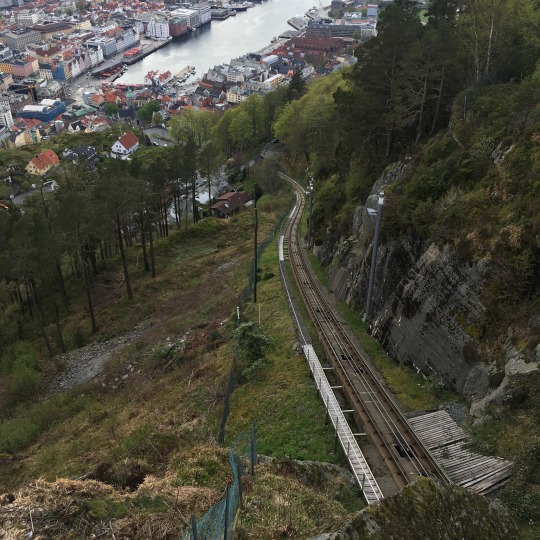
If you are reasonably fit, I recommend skipping the Fløibanen and walking up the mount. The path from city center to the viewpoint is only 3km with a 300m elevation gain, so the ascent is not particularly difficult. The route offers many beautiful vistas of Bergen and its surroundings, with the most remarkable of these views at the very top.

This concluded our brief stay in Bergen. Onward to Trømso!
1 note
·
View note
Text
Norway in a Nutshell - a remarkable journey
Short version - the journey to Bergen through Flåm included the most beautiful, remarkable scenery I have ever seen. It is worth spending a night in Flåm.
A step by step breakdown of this multipart journey follows.
One of the first things we came across when researching Norway was the Norway in a Nutshell tour. While it is billed as a “tour”, there are no guides - in fact, the entire tour takes place on public transportation. You can book the entire trip yourself without the aid of the booking company, and there are several online tutorials to this end. We pressed the easy button and booked the trip through Norway in a Nutshell.
The first leg of the journey is an NSB train from Oslo to Myrdal Station. Wonderful scenery starts almost immediately after leaving Oslo. The train passes through Geilo (seen below), a popular skiing destination. It still had plenty of snow and skiers in early May.

At Myrdal Station, we transferred to the Flåmsbana, a 20km railway that terminates in Flåm. The gradient on this railway is 1:18 (one foot drop for every 18 feet forward). This might not sound like much, but this makes it one of the steeper non-cog railways anywhere. There is a lot to see on the way to Flåm; the train thankfully takes it slow and even stops for 10 minutes at one of the larger waterfalls. I’ve never seen so many waterfalls. Below is the Rjoandefossen, with a 482 ft drop.

After an hour of views like this, we arrived in Flåm, and things only got better. The view from the Flåm harbor out to the Aurlandsfjord is absolutely stunning:

The trip from Oslo to Flåm took a bit over 5 hours. Many people on the train with us continued on to a fjord cruise from here. At least for us, I am certain this would have been folly. We hit the point of sensory overload by the time we reached Flåm. We spent the next day enjoying the cool air, soaking in the sights, and doing a bit of hiking. Even in the early part of the season, hotels are quite expensive. We were fortunate to book a cabin at the Flåm Hostel, which was much more reasonable.
The following day, we took a fjord cruise from Flåm to Gudvangen. This covers two fjords - the Aurlandsfjord and the Nærøyfjord. The topography is absolutely insane - sheer walls extend almost 6000 feet straight up on both sides of the water at times, with innumerate waterfalls lining the mountainsides. Beautiful villages dot the valleys between mountains.
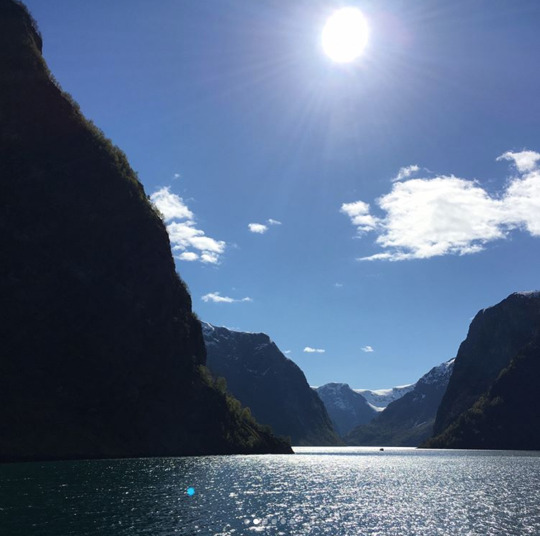

I thought the tour ended at Gudvangen and that the bus trip from Gudvangen to Voss was simply a necessity to reach the nearest train station. Nope! The bus takes a detour down the Stalheimskleiva (known locally as the “hairpin road”), the steepest road in Northern Europe (1:5 gradient). It was a bit of a white knuckle ride; it seemed impossible that a bus could make the turns. The road offers an outstanding view of the valley that ends at Gudvangen.
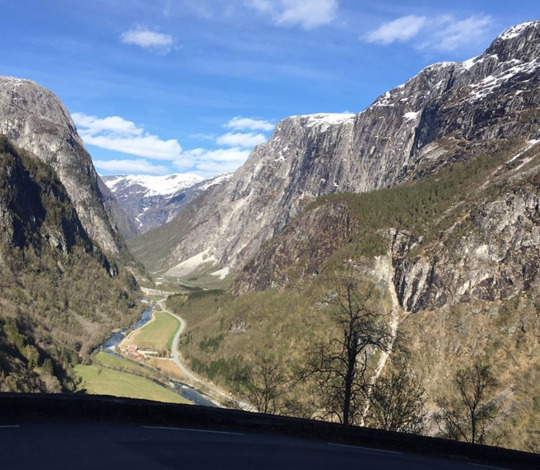
The final leg of the trip is an NSB train from Voss to Bergen, arriving right around 9pm, which of course meant we had almost an hour of sunlight to work with :).
Words and pictures don’t do this tour justice. If you’re anywhere close to Norway, find a way to make this happen. Again, both days sightseeing felt quite full. While it is certainly possible to cram all of this activity into a single day, I recommend making it a two-day trip if at all possible.
1 note
·
View note
Text
Departing Oslo
Noway has existed in some form since the 13th century, so I expected Oslo to feel like your standard Pretty Old European Capitol: Super old buildings of historical import on every other corner. I could hardly have been further from the mark. Oslo feels more modern than many American cities. It is eminently walkable and has excellent public transportation in spite of its modest population. Norway is known for its natural beauty so we only scheduled a few days in Oslo in favor of getting out to the countryside. I am writing this on a train to Flåm. Some thoughts and observations on Oslo in no particular order:
* The tour of parliament (Stortinget) was one of the best things we did in the city. Tours are fist come, first serve and are limited to 30 people, so arrive a bit early, at least on weekends. Great history lesson and an excellent collection of artwork to boot.
* The Vigeland installation at Frogner Park was another highlight.Gustav Vigeland’s sculptures feel very relatable and engaging. The installation includes over 200 of his works in a beautiful setting.
* I found the Munch museum unimpressive. The right layout for a single artist museum is chronological because it better allows the visitor to understand the evolution of the artist. The Munch museum is arranged thematically, and the collection is quite small (~140 pieces) with no placards explaining the works.
* Grünerløkka appears to be Oslo’s answer to the Mission in San Francisco. It’s a “gentrified” working class district - nobody can afford to live there, but it is still mostly a shitbox.
* I found Norway's Resistance Museum (Norges Hjemmefrontmuseum) quite compelling. One gets the impression that civil disobedience played a larger role than armed resistance, which makes sense given that Norway’s military was hopelessly overmatched.
* I’ve never seen better dressed men anywhere. During the workday, every other man appeared to be wearing a bespoke suit. Pretty sure the men in Oslo are more fashionable than the women.
0 notes